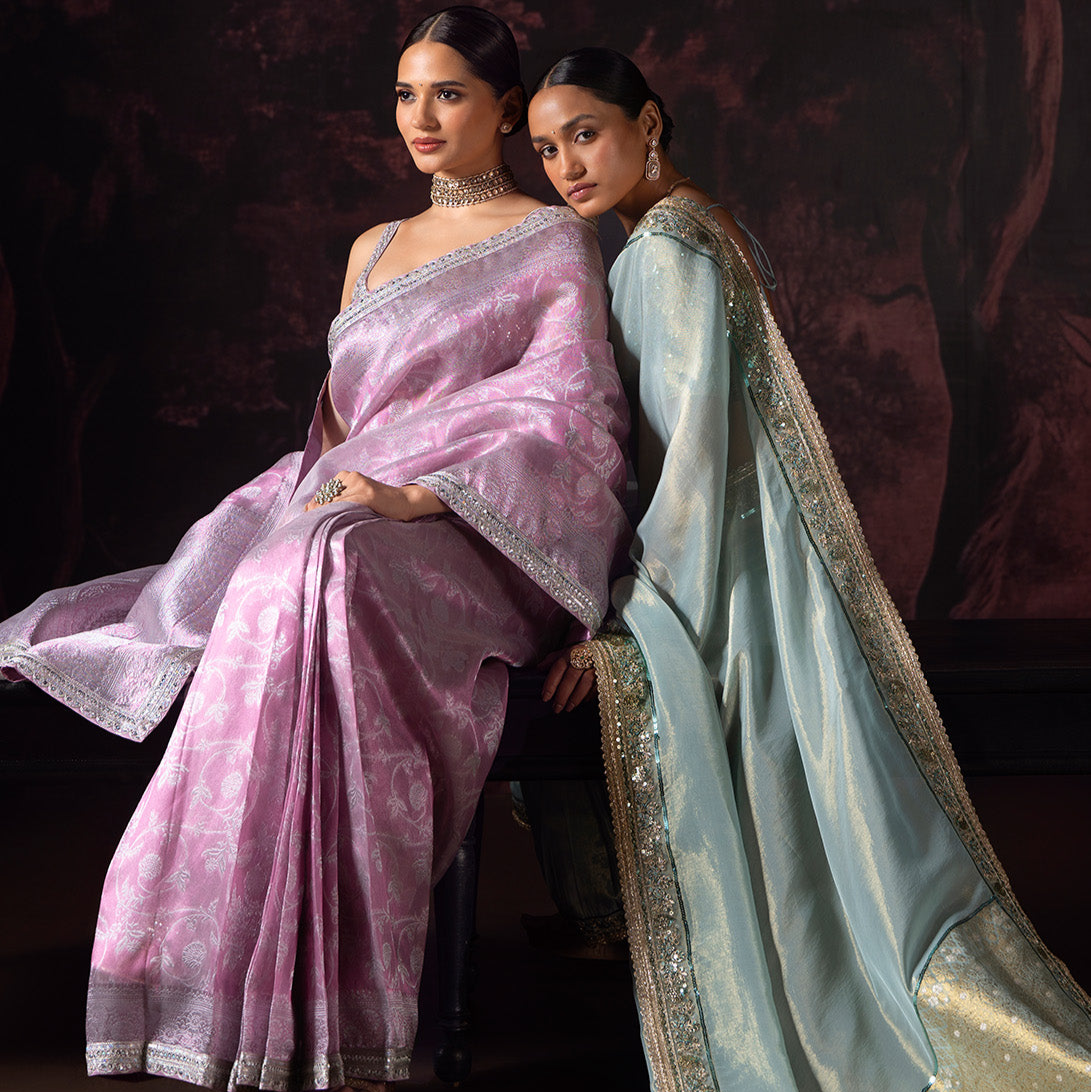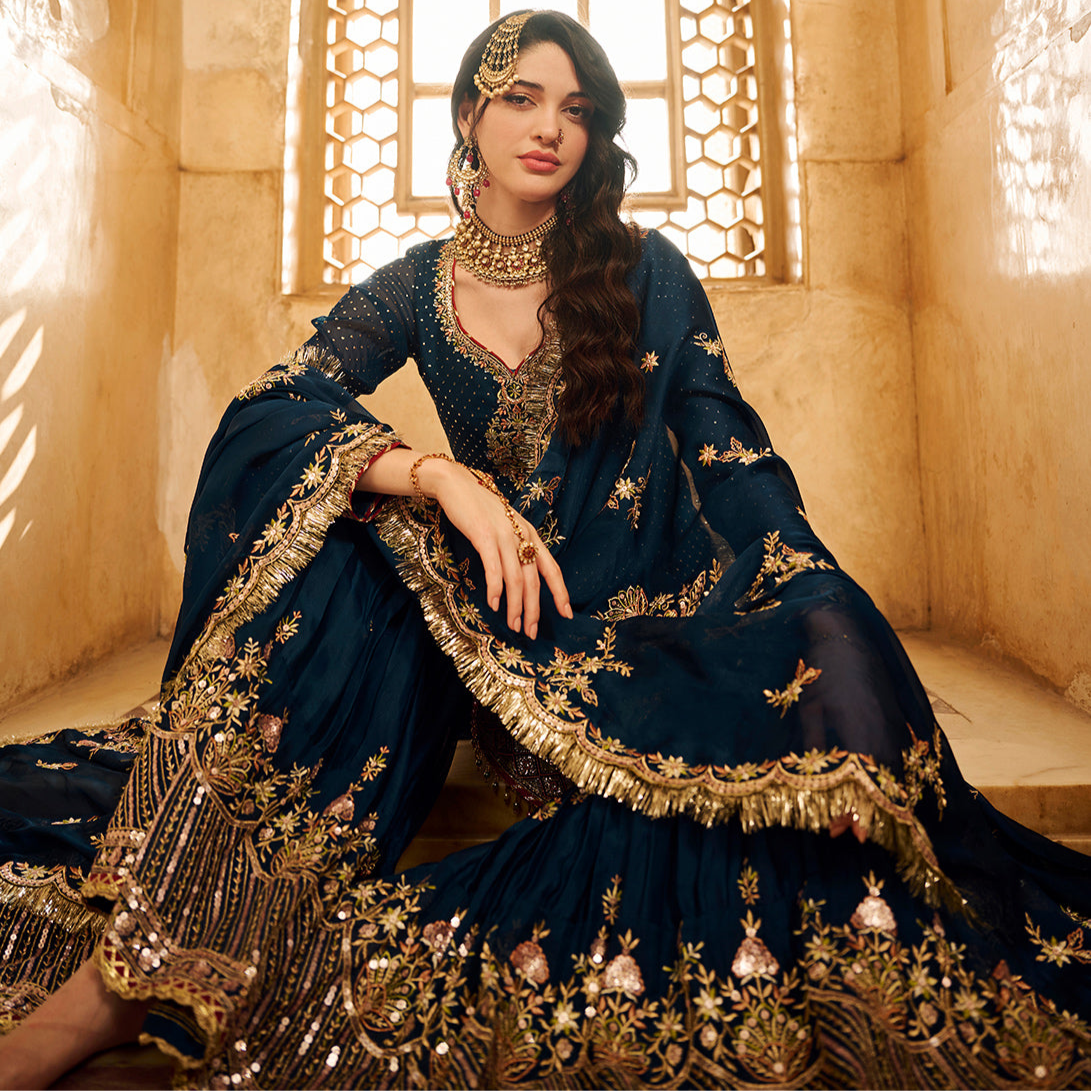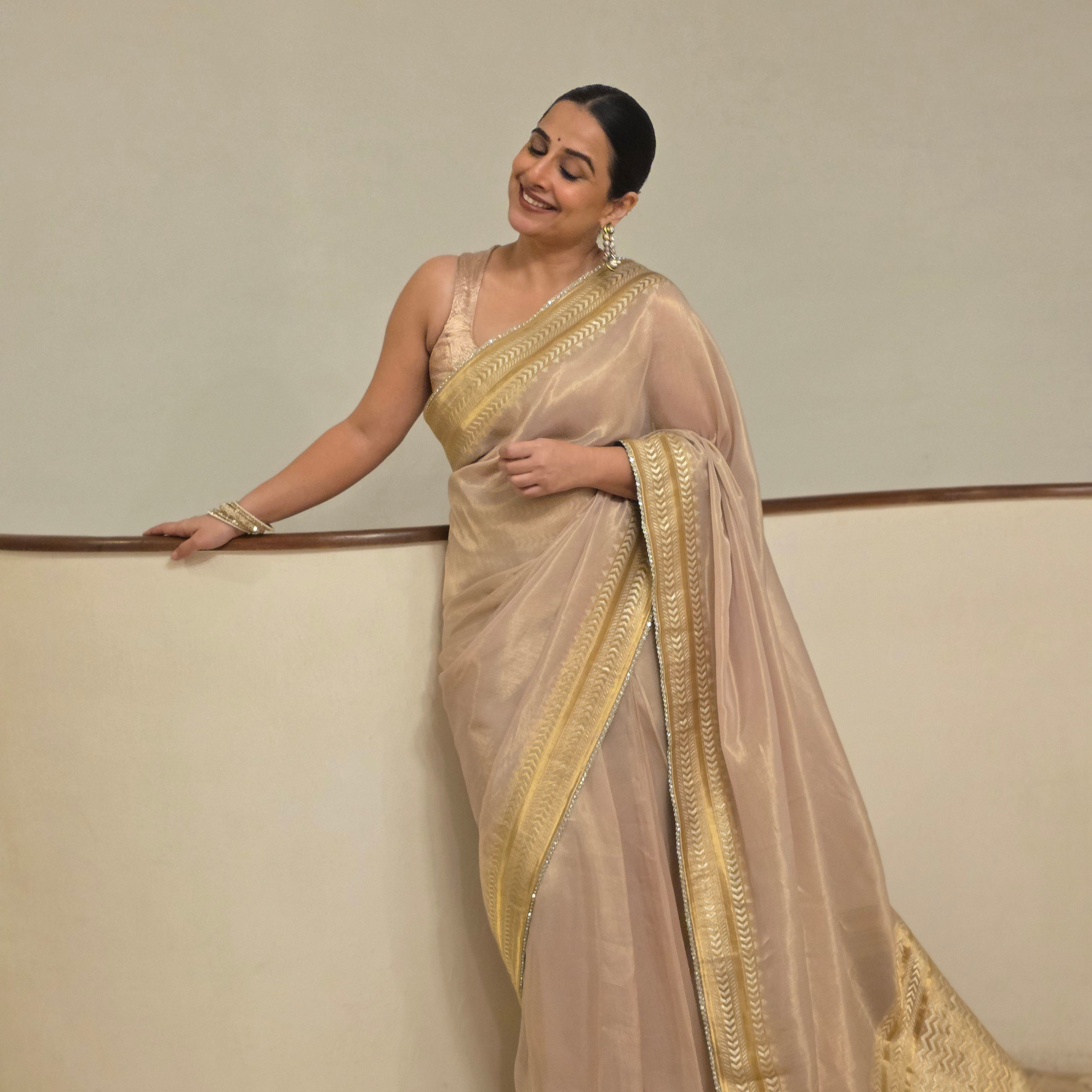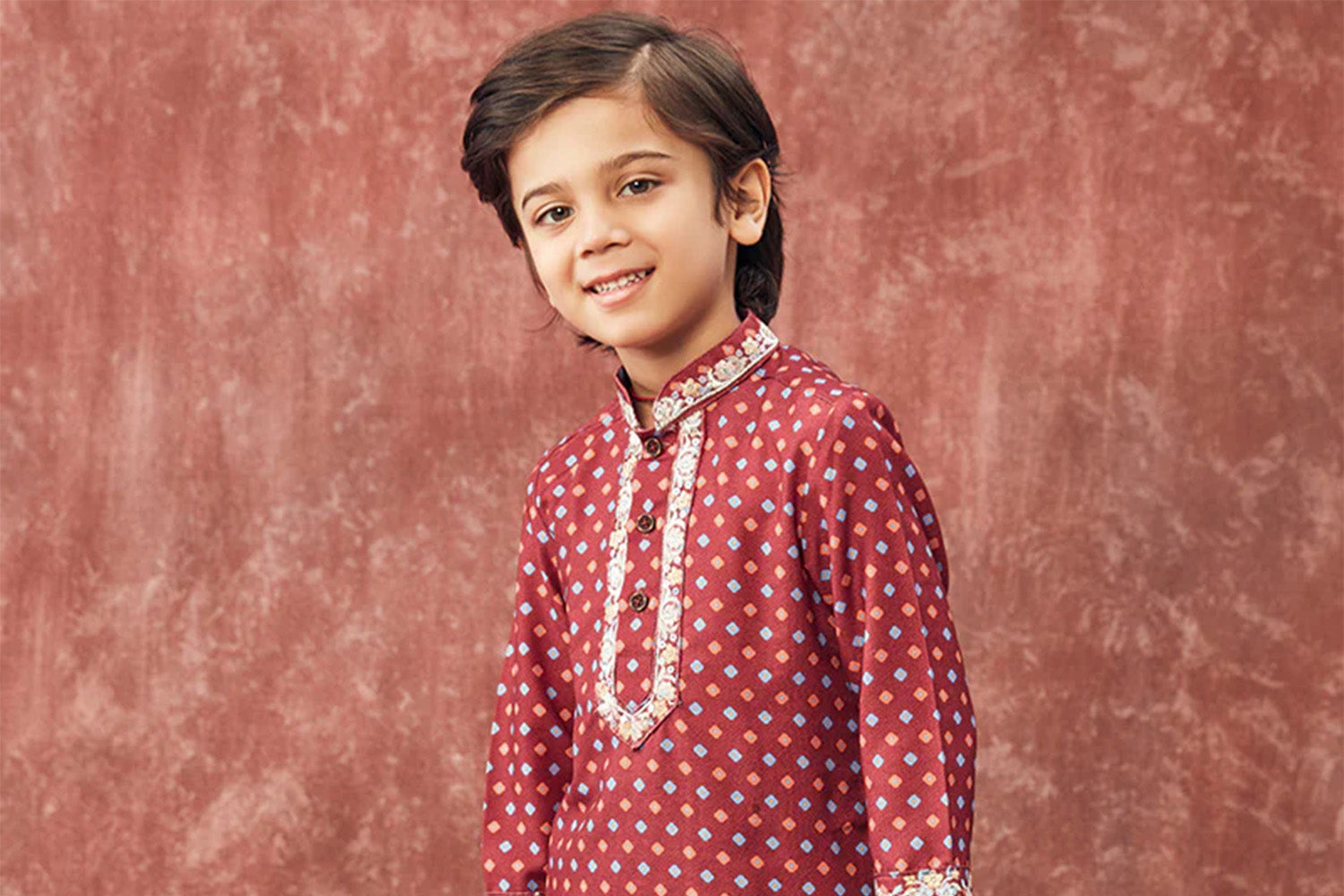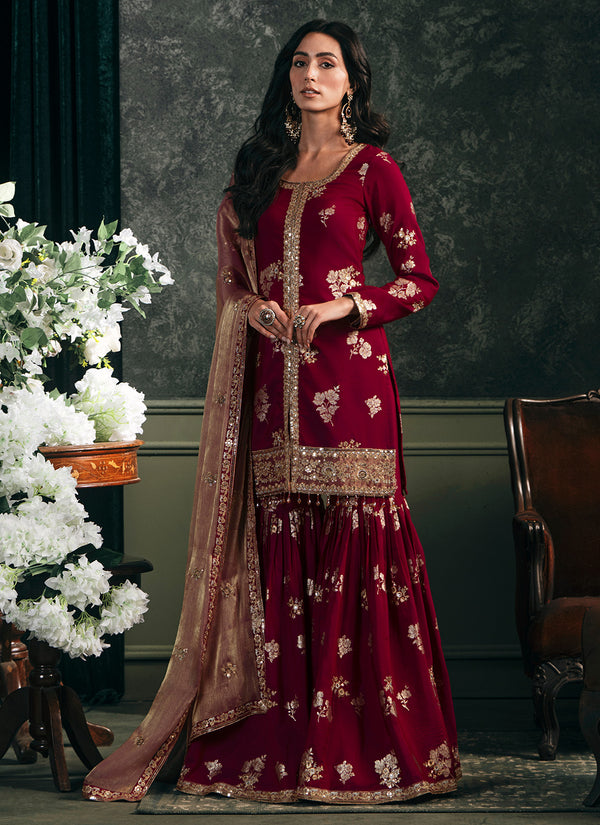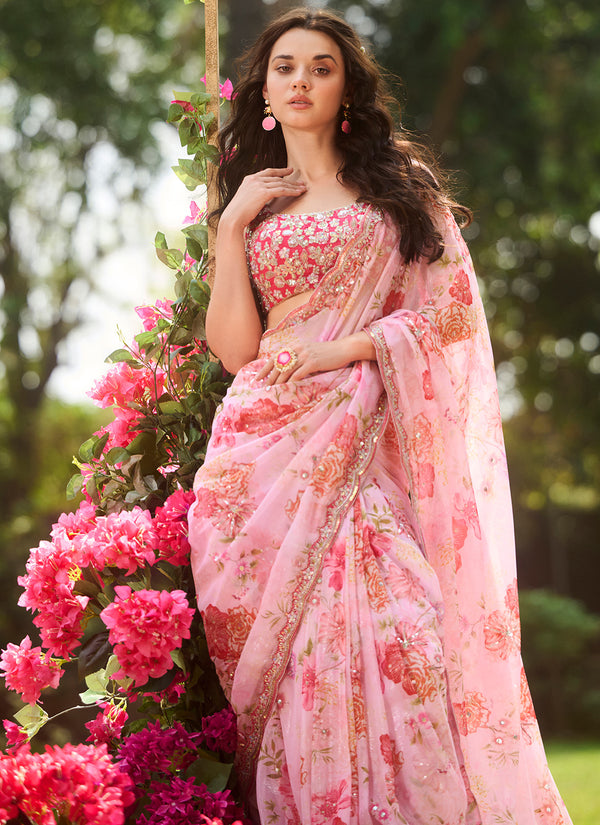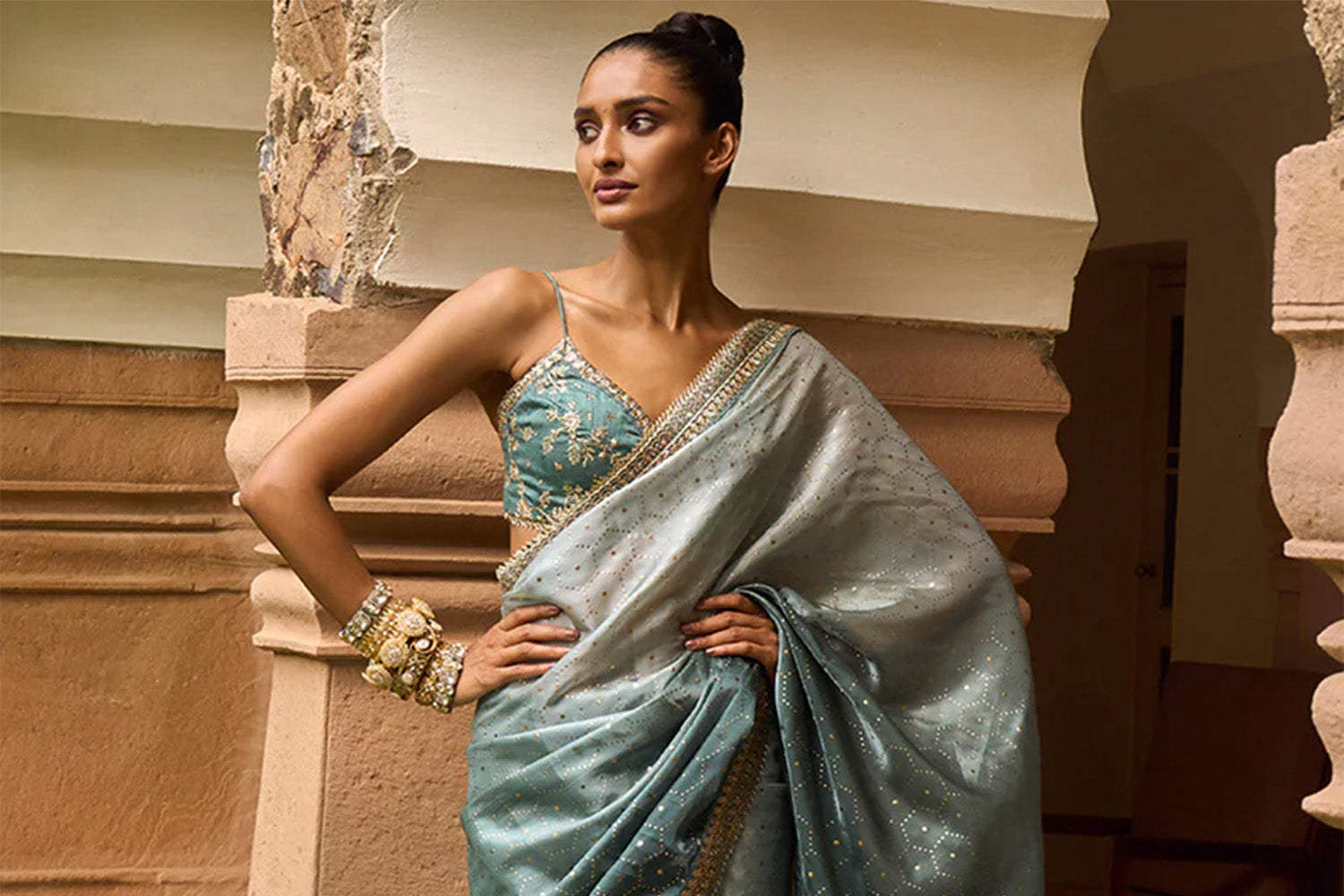
What Is an Organza Saree? Five Styling & Care Tips
Just in the way that color can set the tone for a look, so can fabric — especially the outermost layers that the world sees.
Velvet is a fine choice for winter, and silk makes for some of the most gorgeous lehengas out there. Organza sarees are some of the most beautiful staples in Indian fashion and are perfect for the warmer summer months.
While this gorgeous fabric provides a unique sort of dimension that others cannot, this delicate material does require a particular standard for styling and care. Let’s take a look at organza sarees and learn about the best ways to style them and how best to care for these beautiful and vibrant statement pieces.
What Is Organza?
Organza is a very thin, lightweight, and often transparent fabric traditionally made from silk. In modern times, organza is now woven from a number of fibers like nylon or polyester.
Depending on the exact type of fibers used, the textile design can also give organza a bit of a shimmery and almost shiny appearance. Very thin and breathable, it is easy for embroidery needles to punch through. As such, it’s ideal for beading and is a great way to add another layer and cover up without weighing yourself down in heavy or non-breathable fabrics.
Why Is Organza Good for Sarees?
In addition to being lightweight and more comfortable during the warmer months of the year, pieces like our Multicolor Green Satin Organza Saree add movement, dimension, and character to your outfit.
With organza taking on a glimmering sort of appearance all on its own, it’s very easy to further enhance with beading, sequins, mirror embroidery, and zari work. Organza is a fine choice for longer and more dramatic sarees, giving you the eye-catching look you’re going for without being too heavy to carry or drape over your shoulder.
Depending on the level of embellishment, organza sarees can be suitable for casual and special occasions.
What Goes Underneath Organza?
You’ll want to layer your saree with some sort of blouse and a base skirt, sometimes referred to as a petticoat. Unlike kurtis or other blouses you wear at home or on casual days, the top you wear under your saree will generally be a little more form-fitting.
It doesn’t necessarily need to be tight — but loose garments can get lost in the layers of your saree, add unnecessary weight, and might look a little bulky. Remember, organza is one of the more voluminous materials out there.
Many of these blouses may be cropped, with sleeve lengths ranging from spaghetti strap to full-length sleeves.
These blouses may be the same color as the petticoat and match different elements of the saree. Or, they might even be a different color for those looking for a modern color-blocking design. Some blouses may be a simple solid color, while others might be embellished with elaborate beadwork or other designs complimenting the rest of your ensemble.
The petticoats get their individual flair from the many cuts and shapes which are available. Mermaid-cut silhouettes are fitted around the waist and thighs but flare out around the knee. Many retailers might also refer to this as a trumpet shape.
Some dresses may be a bit more slim-fitting with a small slit cut up the side for mobility. Others feature built-in shapewear for an added slimming and smoothing effect. If you are wanting to make a statement and create an A-line effect, full crinoline underskirts are the choice for you.
What Goes With Organza?
Styling goes so much further than choosing what blouse or skirt to pair with your saree. Shoes, jewelry, hairstyles, and even cosmetics all have their own special ways of coming together and adding a touch of style, extra flair, and a little something special to your look.
In addition to coordinating colors, patterns, and other metallic details to your saree, consider copying the fabric as well. Potli bags wrapped with organza to match the material on your saree is another unique way to put your outfit together with noticeable attention to the details.
Again, organza is one of the thinner materials on the market, making it easy for any embroidery needle to puncture. This allows for even more embellishment to the most basic of accessories, guaranteeing you will stand out in a crowd against all others.
Jewelry: How To Pick the Perfect Piece
Jewelry is a more flashy way to bring out the nicer features in your saree and tie your look together even more. Dramatic stacks of bangles to match your glittery organza will catch the eye of partygoers, making sure you are the center of the show.
Stud earrings, nose rings, delicate necklaces, and anklets are other ways to play up your look without the risk of accidentally snagging the organza material. Rings, necklaces, and other types of bracelets are fine, so long as you are mindful of any hooks, beads, or other pieces that may accidentally get caught.
Hair and Makeup: Looks You’ll Love
Another fun and festive way to make your saree stand out is to put a little extra time into your hair and makeup. You might consider wearing your hair down but draped over one shoulder to fully allow your saree to be seen. Braids with brightly colored ribbons are another fabulous way to stand out in a crowd.
If you really want your delicate organza saree to be the center of the outfit, look for eyeshadow, blush, eyeliner, or lipstick that compliments your saree’s hue.
If you want to keep your makeup a bit more subtle, eyeliner, sheer blush or rouge, and moisturizing lip balms with just the slightest hint of color are wonderful ways to tie in your look. They can also give the younger girls in your family a bit of a chance to experiment with cosmetics.
How Do You Clean and Store Organza?
Organza is a delicate material requiring a little bit more care than cotton or denim. However, a special trip to the dry cleaners is not necessary!
This delicate fabric can easily be cared for at home. Taking a few extra steps to be more gentle with organza sarees when washing and storing them can keep the vivid colors from fading, delicate beading from unraveling and falling off, and prevent the fabric from fraying.
1. Washing
Organza should specifically be hand-washed. Most modern washing machines do feature a delicate or hand wash cycle, but they may not be the best to use on fragile fabric like organza, particularly sarees embroidered with fragile embellishments.
The safest option is to wash organza sarees in a sink or wash basin filled with cool water and a few capfuls of a delicate washing solution.
If you don’t have a delicate wash solution handy, one or two spoonfuls of a light laundry detergent will do just fine. Traditional laundry detergent may be tougher to fully remove from the garment, leaving behind stains or even oily spots, so take care not to overload the sink.
First, spot treat your stains. Try dabbing a bit of the gentle wash aid directly onto the stain and massaging in with your finger. Then, soak the garment as you normally would.
You’ll want to ensure the garment is fully submerged. Stir the water for a few seconds to create a soft lather and ensure the entire saree is evenly washed. Let the saree soak in the solution for no longer than 30 minutes.
After 30 minutes, empty out the wash basin or remove your sink drain. Double-check that the basin or sink is free of soapy residue, then run the saree underneath cool water till it runs clear underneath and there is no more soap being rinsed out.
2. Drying
Avoid wringing out the fabric. This could cause embroidery and other details to get crushed, and it could also stretch out the fabric. Instead, press out excess water.
Organza sarees should be air-dried. Do not put them in the dryer. Lie them flat in their regular shape, or drape them on a drying rack.
Most organza sarees will be a little wrinkly after washing.
This is perfectly normal for this type of fabric. Irons might be too hot for organza and could actually burn holes into the fabric, especially organza that’s been blended with other materials like nylon or polyester. (Irons also don’t work so well with beaded or threaded designs.)
A garment steamer is the best option for removing wrinkles from organza. If ironing is the only option, use the lowest setting possible, turn the garment inside out, and consider using a pressing cloth as an extra barrier of protection from high levels of heat.
Misting the garment with a little bit of cool water will also make it easier to remove stubborn creases and folds from the fabric.
A Few More Care Tips
Your saree should be stored in a cool, dry place and out of direct sunlight to prevent fading. Hanging over long periods of time could cause permanent creasing on the delicate fabric.
Every now and then, you might want to refold your saree to prevent permanent creasing, which can also lead to the fabric fraying and breaking. The best way to store organza sarees is wrapped inside a muslin cloth and inside a dresser drawer.
Try to be careful when wearing your saree. Jewelry can snag the fabric, as can hangnails and dry patches of skin. An easy way to prevent this accidental mishap is to make sure your hands are lightly moisturized before you start dressing yourself or others.
Lastly, if you are layering an organza saree on top of a blouse and/or skirt with elaborate beadwork, take care to make sure your saree is not accidentally upside down or inside out in parts. This is another easy way to prevent accidental snagging or fraying.
The Bottom Line
Organza might require just a bit more extra care than some other fabrics, but a few small steps can be taken to preserve these beautiful garments for years to come. You can absolutely keep them just as gorgeous as they were the day you purchased them.
Organza sarees are a staple in any wardrobe, particularly for special occasions, and they are easily maintained with cleaning supplies you probably already have in your home.
With each of our garments available to be custom-measured and rush-delivered, you are sure to find something to outfit your whole family for every one of the year's occasions. This year, try featuring your whole family in one of the world’s most gorgeous fabrics.
Sources:
How do I store antique textiles at home? | Smithsonian Institute

